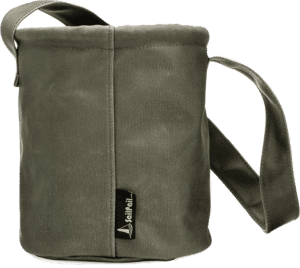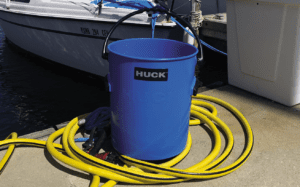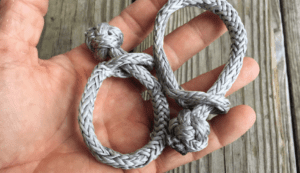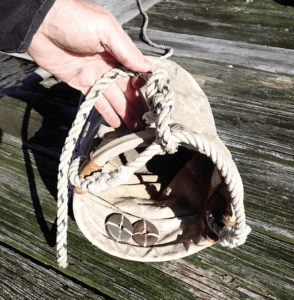A recent test report reacquainted me with an age old problem, that has not yet fully been solved: How can one person, absent a pump, most easily move water from one place to another. The answer, so far as we can tell, remains the same as it was more than a millennium ago—the humble bucket.
This thought occurred as I sluicing seawater over our test bottom paint test panels as called for in the test protocol. First, I grabbed a 5-gallon bucket from dockside. I tied on a rope and attempted to carefully fill it only halfway before lifting. Frequently, the buckets were over-filled and too heavy to lift repeatedly without straining a muscle. I gave up on the 5-gallon bucket and grabbed a 2 ½-gallon wash bucket from the boat. On the fourth pull ,it began disintegrating, cracking down the side and the rim began losing chunks of plastic. I ran down to the hardware store and plunked down $6 for a 2 ½-gallon bucket to finish the job.
BUCKET BASICS
I’ve never kept a 5-gallon bucket on a boat. They’re too heavy to move around, too heavy to haul up on a rope, too big to store, and larger than I want to mop the deck. On spring cleaning and rope cleaning days I will relent and bring big buckets from home. I’ve had a series of unremarkable 2 ½-gallon buckets. I generally replace the wire handles with rope so they won’t scratch the gelcoat. A rope handle is also less prone to tearing out of the bucket. But it also causes flexing that probably reduces the lifespan of the buckets. A worthy compromise, but not that satisfactory.
I’ve missed my canvas bucket, the one I sewed 30 years ago as a hand sewing learning project. You can’t scrub the deck with it—the mouth is too small for the brush and it slowly leaks.
A canvas bucket is really only for useful hauling water from the sea, either to dump over your head, over the deck, or to fill a plastic wash bucket. But it is strong, easy to fill from the sea, and sustains a connection with seafaring tradition.
It’s perfect for rinsing teak decks, which thrive on a regular seawater bath. It’s also good for quickly sluicing fish guts and bird bombs. When going up the mast, it’s a handy place to keep tools or parts for whatever project I’m working on. A bucket of about 1 ½ to 2 gallons is about right.
I’ve read that you can use a bucket as an emergency drogue. First and most obvious, if it can generate enough drag to help slow your boat in big waves, it won’t be something you can easily haul aboard. But second, everything about it is wrong for this purpose from a hydrodynamic perspective. It will not tow in a steady manner, so the amount of drag will fluctuate from too much to too little. And what sort of bucket can withstand the many hundreds of pounds of tension a drogue must?
Chuck the bucket as a drogue idea. Instead, either buy a commercial drogue and practice with it (see “Sailing Without a Rudder,” PS June 2017 and “How Much Drag is a Drogue,” PS September 2016) or practice with a jury rigged fender + anchor drogue which has also been tested by PS and proven by cruisers across oceans.
BUCKET REQUIREMENTS
The World Sailing Offshore Rule requires two buckets for emergency bailing. Sump pumps are also required, but as the saying goes: “Nothing beats a scared man with a bucket.” This might be true for speed and reliability, but not endurance. While the bucket has proven a faithful companion to ankle-deep sailors, you can’t bail all night or while sailing, so a high volume powered sump pump is still a good idea.
For those who like to do things by the book, here are the details of the buckets required under the World Sailings Offshore Special Regulations, the guidance used by ocean-going race boats:
** 3.23.1 a) two strong buckets, each with a lanyard and of at least 9 l (2.4 US Gal) capacity
This standard reaffirms our belief that a 2.5- to 3-gallon bucket is a good, manageable size. Most fire buckets are 2.5 gallons, through they have the additional requirement of being metal.
COMMERCIAL OPTIONS
We looked at several varieties of buckets, or accessories that could double as buckets in a pinch.
Tool bags (Klein and others) with reinforcing rope around the opening will serve in a pinch. Plastic bottoms hold up better than leather. Look for a sturdy rope handle. No pockets or organizers. They typically have drain holes you may want to plug—or not depending on the use.
Add about 3-4 ounces of weight at the lip so it tips and fills faster when you drop it in the water. This ensures the rope rim reinforcement won’t cause it to float. You can also use three to four 5/8-inch hot dipped galvanized washers (about 1-ounce each) from the local hardware. Sure, they will rust eventually, but that’s part of the look. Don’t add too much weight, or it will hang crooked when used as a tool bucket up the mast and fall over when set on the deck.

KLEIN 5106
An industry standard tool bucket, the stiffener is a bit too much for hauling water, but it’s perfect up the mast. It is 9” x 14” and holds 3.8 gallons. $36 Recommended.
ESTEX TOOL BUCKET 2022
Nothing special about this bucket, but it has served us well for 30 years, both at home, on the boat, and at work. We spliced a new rope last year after the original became untrustworthy. I added a few washers (4 ounces) to one side to help it sink. There is 3/16-inch drain hole in the bottom, but this does not keep us from using it to haul water on deck. Cotton canvas, plastic bottom, and spliced polypropylene rope handle. 8” x 12”, 2.5 gallons. $47 Recommended.

FORTIFLEX FLATBACK BUCKET
Feed buckets can literally take a gnawing. Unfortunately, the reinforced, rounded rim that deters dentures keeps it from sinking quickly. You’ll find them at feed stores, or Tractor Supply. The 2-gallon size is handy and easily modified. The one we found had metal attachment points for the handle—well reinforced plastic also serves well, if not better. $9. Recommended.
SHURHOLD
The 3.5 gallon cleaning bucket with rope handle is as rugged as they come. It measures about 10” x 10”. $23. Recommended.

FLORIDA COAST WATER BUCKET
Handy and well made, this bucket is a little floppy for our tastes and lacks a lip weight. But it’s the right size, holding about 3 gallons. $37.
SAIL PAIL
The stylish, and popular canvas pail is rather small, holding just over a gallon, but handy and just the right stiffness. 6.5” diameter x 9” tall. $18. Recommended.

CONCLUSION
I suppose with the huge water tanks, water makers, and washdown pumps on boats today, a canvas bucket seems archaic. But I find it to be one of those traditional tools, like a stitching palm, that connects me to sailing. And like many traditional tools, it reached the
zenith of development in the 19th century and has not really been improved upon since.
You’ll also want a plastic bucket that is sturdy enough to sit on. Anyone who has had their marine toilet malfunction knows why this matters. A good plastic bucket is also good for washing decks and bailing.

1. If you’re obsessive about keeping your boat clean, Shurhold claims to have the one bucket you’ll ever need, its $75 Deluxe One-Bucket, which is actually a 3-in-1 bucket with a wide base, a lid seat, and a carrying caddy for all your cleaners, rags, and polishes (for another $75 bucks you can add Shurhold’s cleaning kit). It also has a grate to trap dirt, so you’ll get more use out of each bucketful of water. You can buy the bucket separately for about $25, but it’s five-gallon size defies our rule not to use anything that might lead to reconstructive shoulder surgery if we try to use underway. Of course, the marina bound sailor who is obsessive about cleaning is likely to have a dock box, where this will find a convenient home. www.shurhold.com

2. We’re impressed by the unique features and formidable strength of the Huck Performance Bucket, but we have trouble justifying a $100 for plastic pail, even if it is made entirely in the U.S. of a hip-sounding proprietary material (Sprytech). Truly, this is no ordinary pail, and during the previous six months we’ve put ours through the wringer. Some of the cool details include bottom and side hand grips for bailing, stainless-steel reinforced handle tested to 600 pounds, non-skid feet, UV-resistance, etc.. Like the Shurhold bucket, it will serve the dock-and-hose folks superbly, but 5-gallons is too big for collecting
water on a moving sailboat. www.huckberry.com
3. Costing $7 at a feed store, Fortiflex 2-gallon bucket fits the bill for the low budget sailor. Swap the metal handle for rope.
4. Plastimo overs a $35 version of the Fortiflex. Despite the effor to make a more functional handle, we’d ditch it for rope.
5. Klein’s 12-inch tool bag will double as a bucket in a pinch.
6. The Florida Coast Water


1. To maintain a traditional look, Stone used three-strand rope for the handle and the draw rope. Eye splices on the handle, and the draw rope make it easy to disassemble.

2. The soft shackles were made out of Dyneema. If you’d rather not tie a stopper-knot, you can use an aluminum toggle (see “Making the $2 Dogbone Shackle,” PS October 2021).








































